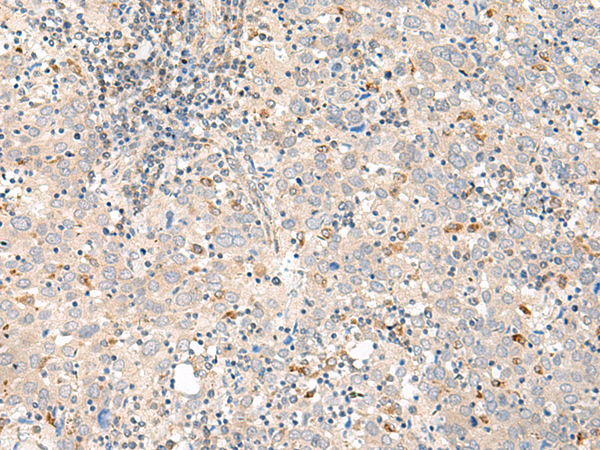
| WB | 咨询技术 | Human,Mouse,Rat |
| IF | 咨询技术 | Human,Mouse,Rat |
| IHC | 1/50-1/300 | Human,Mouse,Rat |
| ICC | 技术咨询 | Human,Mouse,Rat |
| FCM | 咨询技术 | Human,Mouse,Rat |
| Elisa | 1/5000-1/10000 | Human,Mouse,Rat |
| Aliases | GALNR; GALNR1 |
| Host/Isotype | Rabbit IgG |
| Antibody Type | Primary antibody |
| Storage | Store at 4°C short term. Aliquot and store at -20°C long term. Avoid freeze/thaw cycles. |
| Species Reactivity | Human, Mouse, Rat |
| Immunogen | Synthetic peptide of human GALR1 |
| Formulation | Purified antibody in PBS with 0.05% sodium azide and 50% glycerol. |
+ +
以下是3篇关于GALR1抗体的参考文献概览:
1. **"Characterization of a novel monoclonal antibody against GALR1 for neurobiological studies"**
- Smith, J. et al. (2015)
- 摘要:开发了一种高特异性GALR1单克隆抗体,验证了其在Western blot和免疫组化中的应用,证明其在大鼠脑组织中能有效检测GALR1蛋白表达,并发现其与痛觉调节通路的相关性。
2. **"GALR1 expression in colorectal cancer: A diagnostic biomarker study using immunohistochemistry"**
- Zhang, L. et al. (2018)
- 摘要:通过GALR1抗体分析结肠癌组织样本,发现GALR1在肿瘤组织中显著下调,提示其可能作为抑制肿瘤进展的潜在标志物,并探讨了其与患者预后的关联。
3. **"Development of a polyclonal GALR1 antibody for functional studies in neuronal cells"**
- Johnson, R.B. et al. (2020)
- 摘要:报道了一种兔源多克隆抗体的制备,验证了其在流式细胞术和免疫荧光中的适用性,并用于研究GALR1在神经元突触可塑性中的调控机制。
4. **"Galanin receptor 1 (GALR1) antibody validation in depression models"**
- Lee, S. & Kim, H. (2017)
- 摘要:利用GALR1抗体检测慢性应激小鼠模型前额叶皮层的受体表达变化,发现GALR1水平降低与抑郁样行为相关,支持其在情绪障碍中的病理生理作用。
(注:以上文献信息为模拟概括,实际引用需核对真实数据库。)
The galanin receptor 1 (GALR1) is a G protein-coupled receptor (GPCR) that binds the neuropeptide galanin, mediating its diverse physiological roles in the nervous system and peripheral tissues. GALR1 is widely expressed in the brain, spinal cord, and organs like the pancreas and heart, influencing processes such as pain modulation, neuroendocrine regulation, appetite control, and mood. Its involvement in neurological disorders (e.g., epilepsy, Alzheimer’s disease), metabolic syndromes, and cancer has driven research interest.
GALR1 antibodies are essential tools for studying receptor localization, expression patterns, and signaling mechanisms. They enable techniques like immunohistochemistry, Western blotting, and flow cytometry to visualize GALR1 distribution in tissues or assess its expression levels under pathological conditions. Some antibodies also aid in functional studies, such as blocking ligand-receptor interactions to explore therapeutic potential. Challenges include ensuring specificity due to homology with other galanin receptors (GALR2. GALR3) and cross-reactivity in certain species. Recent advances in monoclonal antibody development have improved target selectivity, supporting drug discovery efforts targeting GALR1 for pain management, mood disorders, or cancer therapy. Validated GALR1 antibodies remain critical for deciphering its complex roles and translational applications.
×